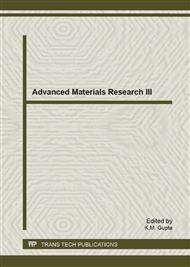p.19
p.24
p.30
p.35
p.40
p.45
p.50
p.57
p.63
Wear Behavior of Al-20Vol. %SiCp Composites Manufactured by Dynamic Consolidation
Abstract:
Dynamic consolidation is the route that can be used as a processing method to produce aluminum-matrix composite. This process offers several unique advantages over the static compaction methods in conventional powder metallurgy. Al-20vol.% SiCp composites were manufactured by direct explosive compaction with various explosive pad thicknesses that resulted in densities of compacts from 92% to 98.5% TD. The wear behavior of the various compacts was evaluated using a pin-on-disc wear tester. The microstructure characterization was performed using light microscopy. The dominant wear mechanisms were evaluated using scanning electron microscopy. The results showed that the sliding wear resistance increased with the increase in the density of the compact composites.
Info:
Periodical:
Pages:
40-44
Citation:
Online since:
April 2013
Authors:
Keywords:
Price:
Сopyright:
© 2013 Trans Tech Publications Ltd. All Rights Reserved
Share:
Citation:


